Optics Master
Structure
It is just Drag and Drop to insert the parts, wherever you want, from parts database list, and panel layout is performed.
The structure is shown in 3-D CG which helps you to clarify the whole panel’s conformation. Since the display of the degree of optical axial angle of an anisotropy medium, a transmissive type model, and a reflective type model is also displayed by CG, the panel structure can be checked easier before the calculation start and data input mistake can be reduced.
Even if the number of layers increases, the panel composition can be defined in a short time because the structure frequently used with the multilayer film can be defined as sub structure.

Director
The action of the liquid crystal molecule (director) at the time of impressing voltage is calculated. At Dynamic analysis, a time response is calculated and the equilibrium state in specification voltage is calculated by Static analysis.
Weak anchoring
Anchoring energy on the upper and lower LC boundary can independently be specified in azimuth and polar angle.
(EX)Flow
It analyzes using six Leslie constants to time response calculation of a liquid crystal more correctly, and the back flow effect can be checked.
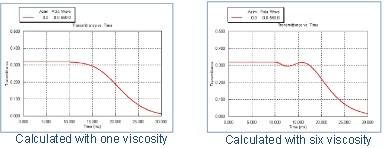
(EX)Flexoelectric effect
Flexoelectric effect is also supported which is observed as
electric polarization when such splay or bend distortion occurs.
By specifying Flexoelectric coefficients e1 an e2, it can show
more close real time-response or n-directors distribution.
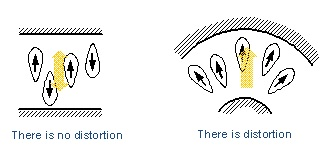
(EX)Tensor order parameter
The analyzing algorithm is like a microscopic simulator by using
order parameters. The Q tensor can reveal not only n-directors
direction but also scalar order parameter time change and spatial
distribution. SHINTECH uses most rigorous theoretical formulae,
different from de Gennes or Berreman’s Q-tensor explication,
which is the first commercial simulator in the world!

Multi-domains cell
It is capable of specifying alignment condition on boundaries of
up to 72 different domains. It automatically calculates director
distribution with different alignment condition on boundaries,
and subsequently performs optical calculation. It then calculates
the average of up to 72 transmissivity and stores it as the
calculation result. This drastically reduces the time and
labor required in calculating multiple domains.
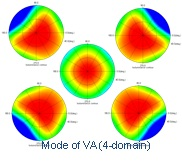
Director distribution illustration
After it calculates for the distribution, the calculation result of director is displayed by the graph and the list.
The item displayed as a calculation result is an electrostatic capacity, and energy (Gibbs energy and Helmholtz energy), etc. in ultra coordinates (θ,φ) in the each level and driving state of each liquid crystal (voltage or time).

Optics
The multilayer film definition of the light element registered into the database is carried out, and the light which spreads the inside of the structure is calculated. There are two of the 2×2 methods which considered reflection as the 4×4 method for having taken multiplex interference into consideration as an algorithm once.
Mueller matrix
Newly an optical calculation function by Mueller matrix is added in .Ver.8 to the conventional optical calculation which was expressing polarization propagation using Jones matrix.
By the new optical calculation by Mueller matrix, Ver.8 has the following new functions.
・De-polarization simulation can be done.
・Partial polarized light can be handled in the incidence polarization.
・The actual data measured by OPTIPRO can be inserted to the database and calculated.
・The polarization data of the light source measured by OPTIPRO can be specified as an incidence polarization.
Insert measured data
A kind of optical film having de-polarization characteristics, such as CF (Color Filter) can be measured by “OPTIPRO” and the data will be dragged and dropped into Ver.8 together with other physically defined materials. You can predict how contrast ratio will be dropped by the CF.
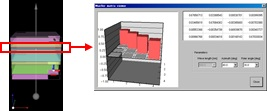
Metal reflector
In addition to ideal mirror it simulates reflective LCDs with metal reflector.
Customers can take more reliable final optical performance of the reflective LCDS.
Parallel processing
Optical calculation will be automatically parallelized by using
this option and consequently the calculation time can be
drastically reduced.
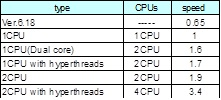
Invisible range (200nm~2000nm)
Following the standard means capability to calculate wavelengths between 380nm and 780nm. This function enables you to expand that range to between 200nm and 2,000nm, and is useful when the user wishes to know transmissivity and polarization in the ultraviolet and infrared regions.
Uniaxial multi-layers
Director distribution is expressed in theta and phi. The angular distribution of the theta and phi will be defined and acquired through a formula. This is useful when simulating a phase compensation film or a cholesteric LC. Available functions include the 4 basic operations, trigonometric functions, and exponential functions. You can use pi for a constant, and Z for a variable with a value from 0 to 1. You can also acquire the value of another point by inputting values of Z coordinate theta and phi that are separately specified other than the above, then performing spline interpolation.
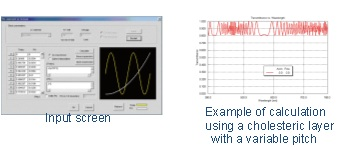
Cell parameter can be scanned
Pretilt, Pretwist, and Cellgap can be specified as a variable or a function by carrying out the check of Variable or Function.
Polarization at each layer
In the panel of multi-layered structure,
it can opt for incidence polarization, and a polarization
state can change between each class how,
or it can be seen by the coordinates plot to the
Poincare sphere, the list display of the Stokes parameter,
and polarization state animation display.

3DTV evaluation
It can stack optical materials at the observational point as
an observational panel as well as conventional LCD panel
defined on the basis of the absolute coordinate.
Especially it is very useful for design 3-D TV eye-glasses.
You can estimate the final optical quality via the eye-glasses
by this function.
As the observational panel can be saved into a disk as a
sub-structural data, you can evaluate the performance
in combination with other conventional LCD panel immediately.
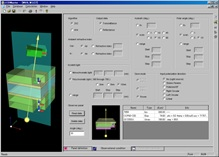
D.O.P.
About de-polarization of the element.
You cannot consider de-polarization if a machine you had does not detect subtle de-polarization.
Let’s define Degree of Polarization (D.O.P.).
α being 0 means randomly polarized light and it being 1 means completely polarized light.
Physically mount of α depends on wavelength or direction of light, but in this case α is the same over whole wavelength and direction.
Default value of α is 1, thus completely polarized light is assumed as default

Reflective output with 4×4
In a transmission panel configuration, the optical calculation results are normally output as transmittance.Use of this function will calculate and output the reflectance in a transmission panel. This function is available only for 4X4 calculation.
Scattering reflector
This is a reflector that generates diffused reflection by defining a
hemisphere on the surface of the metal.
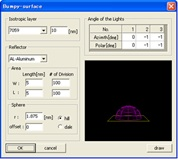
Ray-tracing software data input function
Ver.8 can import calculated result by which SPEOS (French company OPTIS) or LightTools(American company ORA)generate. Luminance and contrast ratio can be evaluated in radiometry or photometry.
Extended biaxial film
Calculation in consideration of absorption of biaxial anisotropic material can be performed. Furthermore we developed new function which deals with a polarizer, of which refractive axis and absorption axis are not the same.
Biaxial multi-layers
Biaxial anisotropic material can define the model located in a line in the direction of the Z-axis.Direction of biaxial anisotropic material is determined by defining
θ, φ, and ψ(Euler angle) as a function of Z.
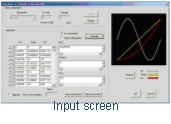
Analyzer
The viewing angle characteristic, a time response and voltage dependability, and the polarization state of transmissivity are displayed by graph or Viewing cone from an optical calculation result, and evaluation analysis is performed.
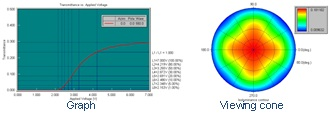
Poincare sphere
Polarization of transmittance or reflectance can be shown on Poincare
sphere. As the sphere can be rotated freely, you will understand more
intuitively the changing of polarization.

Extended color evaluation
Evaluation of a color can be performed using a color temperature and the color gamut.
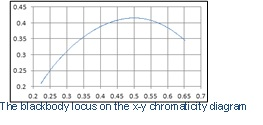
Gamma characteristics evaluation
It calculates transmittance or luminance with gamma correction (control)
Import measured luminance data
Measured luminance data can be imported as light source data.
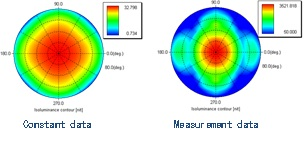
Relationship with EzContrast ( ELDIM )
You can use EDF files under the condition that EzContrast made by ELDIM Corporation is installed.
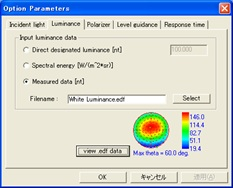
Catalogue
This function is capable of collectively analyzing and displaying multiple files that are calculated with Optics Master.
Results of analysis that can be displayed are Viewing Cone.
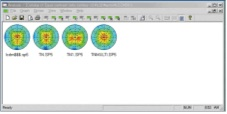
Extended Graph and Contour
The result searched for by the experimental result or the program created uniquely can be displayed by the graph of Analyzer, and a contour.

